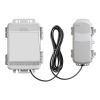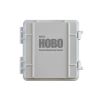HOBOnet Wireless Multi-Depth Soil Moisture Sensor
Features
- 900 MHz wireless mesh self-healing technology
- 450 to 600 meter (1,500 to 2,000 feet) wireless range and up to five hops
- Up to 50 wireless sensors or 336 data channels per HOBO RX station
- Free ground shipping
- Expedited repair and warranty service
- Lifetime technical support
- More
Overview
The Onset HOBOnet Multi-Depth Soil Moisture Sensor is a wireless sensor that works with the HOBOnet system to measure soil moisture and soil temperature at multiple depths with a single probe. This durable sensor is available in three probe lengths, for measurements up to 90 cm (35 in) deep.
Mechanics
Featuring GroPoint's TDT5 technology with patented antenna design, this sensor measures soil moisture along the entire length of each probe segment, resulting in the largest volume of influence per measurement section. A high frequency of pulses per measurement provides precise and consistent soil moisture data.
Applications
The optional pilot rod and slide hammer are recommended for quick and easy installation: the PILOT-ROD4 (28") for use with the 3-segment and 4-segment sensors (RXW-GP3A and RXW-GP4A) and the PILOT-ROD6 (40) for use with the 6-segment sensor (RXW-GP6A).
The HOBOnet system is a cost-effective and scalable wireless sensor network for web-enabled monitoring of field conditions for applications such as crop management, research, and greenhouse operations. Because it's wireless, users can deploy a network of sensors to easily monitor multiple points with a single system, while avoiding the risk of long cables that can interfere with field operations. Sensors are easily linked to the network, and data can be accessed through HOBOlink, Onset's innovative cloud software platform.
| Soil Moisture: Volumetric Water Content (VWC) | ||||||||||||||||||||||||||
| Measurement Range | In soil: 0 to 0.550 m³/m³ (volumetric water content) | |||||||||||||||||||||||||
| Accuracy | ±0.02 m³/m³ (±2%) in most soils typical from 0° to 50°C (32° to 122°F)* | |||||||||||||||||||||||||
| Resolution | 0.001 m³/m³ | |||||||||||||||||||||||||
| Temperature | ||||||||||||||||||||||||||
| Measurement Range | -20° to 70°C (-4° to 158°F) | |||||||||||||||||||||||||
| Accuracy | ±0.5°C (0.9°F) | |||||||||||||||||||||||||
| Resolution | 0.1°C (0.18°F) | |||||||||||||||||||||||||
| Depths Measured (see below) | ||||||||||||||||||||||||||
| RXW-GP3A-xxx | 45 cm (18 inches) total; three soil moisture zones, six temperature depths | |||||||||||||||||||||||||
| RXW-GP4A-xxx | 60 cm (24 inches) total; four soil moisture zones, six temperature depths | |||||||||||||||||||||||||
| RXW-GP6A-xxx | 90 cm (35 inches) total; six soil moisture zones, nine temperature depths | |||||||||||||||||||||||||
| Wireless Mote | ||||||||||||||||||||||||||
| Operating Temperature Range | Sensor: -20° to 70°C (-4° to 158°F) Mote: -25° to 60°C (-13° to 140°F) with rechargeable batteries -40° to 70°C (-40° to 158°F) with lithium batteries |
|||||||||||||||||||||||||
| Radio Power | 12.6 mW (+11 dBm) non-adjustable | |||||||||||||||||||||||||
| Transmission Range | Reliable connection to 457.2 m (1,500 ft) line of sight at 1.8 m (6 ft) high Reliable connection to 609.6 m (2,000 ft) line of sight at 3 m (10 ft) high |
|||||||||||||||||||||||||
| Wireless Data Standard | IEEE 802.15.4 | |||||||||||||||||||||||||
| Radio Operating Frequencies | RXW-GPxA-900: 904–924 MHz RXW-GPxA-868: 866.5 MHz RXW-GPxA-921: 921 MHz RXW-GPxA-922: 916–924 MHz |
|||||||||||||||||||||||||
| Modulation Employed | OQPSK (Offset Quadrature Phase Shift Keying) | |||||||||||||||||||||||||
| Data Rate | Up to 250 kbps, non-adjustable | |||||||||||||||||||||||||
| Duty Cycle | <1% | |||||||||||||||||||||||||
| Maximum Number of Motes | Up to 50 wireless sensors or 336 data channels per one HOBO RX station | |||||||||||||||||||||||||
| Logging Rate | Maximum logging interval: 18 hours Recommended minimum logging interval: 5 minutes year round when using solar power with rechargeable batteries, 10 minutes when using non-rechargeable lithium batteries |
|||||||||||||||||||||||||
| Number of Data Channels | RXW-GP3A-xxx: 10 RXW-GP4A-xxx: 11 RXW-GP6A-xxx: 16 |
|||||||||||||||||||||||||
| Battery Type/ Power Source |
Two AA 1.2V rechargeable NiMH batteries, powered by built-in solar panel or two AA 1.5 V non-rechargeable lithium batteries for operating conditions of -40 to 70°C (-40 to 158°F) | |||||||||||||||||||||||||
| Battery Life | With NiMH batteries: Typical 3–5 years when operated in the temperature range -20° to 40°C (-4°F to 104°F) and positioned toward the sun (see Mounting and Positioning the Mote), operation outside this range will reduce the battery service life With non-rechargeable lithium batteries: 1 year with a 10-minute logging interval |
|||||||||||||||||||||||||
| Memory | 16 MB | |||||||||||||||||||||||||
| Dimensions | RXW-GP3A-xxx sensor length: 53.2 cm (20.9 inches) RXW-GP4A-xxx sensor length: 68.2 cm (26.9 inches) RXW-GP6A-xxx sensor length: 98.2 cm (38.7 inches) Sensor diameter: 3 cm (1.2 inches) Cable length: 3.5 m (11 ft 6 in) Mote: 16.2 x 8.59 x 4.14 cm (6.38 x 3.38 x 1.63 inches) |
|||||||||||||||||||||||||
| Weight | RXW-GP3A-xxx sensor: 351 g (12.4 oz) RXW-GP4A-xxx sensor: 408 g (14.4 oz) RXW-GP6A-xxx sensor: 526 g (18.6 oz) Cable: 180 g (6.5 oz) Mote: 226 g (7.97 oz) |
|||||||||||||||||||||||||
| Materials | Sensor: Polycarbonate housing encasing epoxy sealed circuit board Cable: Polyurethane Mote: PCPBT, silicone rubber seal |
|||||||||||||||||||||||||
| Environmental Rating | Mote: IP67, NEMA 6 | |||||||||||||||||||||||||
- HOBOnet Multi-Depth Soil Moisture Sensor
- Two AA 1.2V rechargeable NiMH batteries
- Cable ties
- Screws
In The News
From Paddles to Phytoplankton: Studying Vermont’s Wildest Lakes
For six months of the year, Rachel Cray, a third-year PhD student at the Vermont Limnology Laboratory at the University of Vermont, lives between a microscope and her laptop, running data. For the other six months, she is hiking and canoeing four of Vermont’s lakes, collecting bi-weekly water samples. Cray studies algal phenology across four lakes in Vermont, US, that have low anthropogenic stress—or in other words, are very remote. Funded by the National Science Foundation Career Award to Dr. Mindy Morales, the lakes Cray researches part of the Vermont Sentinel Lakes Program, which studies 13 lakes in the area and, in turn, feeds into the Regional Monitoring Network, which operates in the Northeast and Midwest US.
Read MoreReimagining Water Filtration: How Monitoring and Science Enhance FloWater Filtration Systems
Over 50% of Americans think their tap water is unsafe , according to the Environmental Working Group (EWG). Other recent surveys have found that number to be as high as 70% of persons surveyed. Whether due to increased public awareness of water quality issues or confusion about how municipal water sources are regulated, there is a clear distrust of tap water in the United States. According to industry expert Rich Razgaitis, CEO and co-founder of the water purification company FloWater, this issue creates a damaging cycle. Razgaitis explained that the health and environmental problems associated with contaminated water aren’t the only issues. As people become increasingly aware that some tap water is unsafe, they resort to bottled water.
Read MoreMonitoring New Hampshire’s Aquatic Ecosystems: Continuous Data Collection in the Lamprey River Watershed
New Hampshire’s aquatic ecosystems provide a range of ecosystem services to the state and region. Resources and services like clean water, carbon storage, climate regulation, nutrient regulation, and opportunities for recreation all depend on New Hampshire’s aquatic ecosystems remaining healthy. Jody Potter, an analytical instrumentation scientist at the University of New Hampshire (UNH), is studying these aquatic ecosystems in hopes of developing an improved understanding of ecosystem services and their interactions with climate change, climate variability, and land use changes. [caption id="attachment_39799" align="alignnone" width="940"] Aquatic sensors in the Merrimack River in Bedford, NH, with I-293 in the background.
Read More















